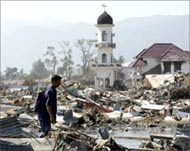Mangroves offer tsunami protection
The massive waves from last year’s tsunami did their worst damage in communities that lacked protection from mangrove forests and other natural barriers.

The World Conservation Union or IUCN said it hoped that its findings would motivate hard-hit communities across Asia to consider replanting mangroves – a quarter of which have been destroyed since the 1980s in tsunami-impacted countries due to development and the rapid growth of shrimp and fish farms.
Achim Steiner, director general of the Swiss-based IUCN, said: “Damage could have been prevented with a healthy mangrove barrier protecting the shoreline.
“Now that the emergency is over, it is time to start reconstructing the environmental infrastructure of the region”.
The massive wave last December struck 12 countries, leaving more than 216,000 people dead or missing.
Sand dunes
Based on surveys of tsunami-hit regions, the IUCN found that villages with mangrove forest fared much better than those exposed to the open seas.
Their findings reflect those in India where the presence of mangrove forests and other barriers like sand dunes were credited with saving lives.
 |
|
Entire villages were destroyed |
The IUCN found that only two people died in the Sri Lankan village of Kapuhenwala which was surrounded by 200 hectares of dense mangroves and scrub forest.
In contrast, nearly 6000 people died in the nearby village of Wanduruppa, where mangrove forests had largely been wiped out, it said.
A separate study released in October by researchers led by Finn Danielsen of the Nordic Agency for Development and Ecology in Copenhagen, Denmark, reached similar conclusions.
Earlier estimates by the Global Environment Centre in Malaysia found that governments in Indonesia, India, Malaysia, Sri Lanka and Thailand will need to spend a total of more than $30 million to plant mangroves and other beach vegetation such as casuarina trees on 1300km of their coastlines.
Rebuilding ecosytems
Initial efforts by aid organisations to replant mangroves faltered because many lacked the technical expertise.
But in recent months, a coalition of environmental groups have teamed up with governments across the Indian Ocean basin to launch programmes aimed at rebuilding coastal ecosystems and reviving their local economies.
The IUCN said it had started restoring hundreds of hectares of mangroves in Sri Lanka and southern Thailand which were hit by the December 2004 tsunami.
It also launched Mangroves for the Future, a $45 million programme that is directed to build natural barriers of mangroves in twelve countries in Asia and Africa.